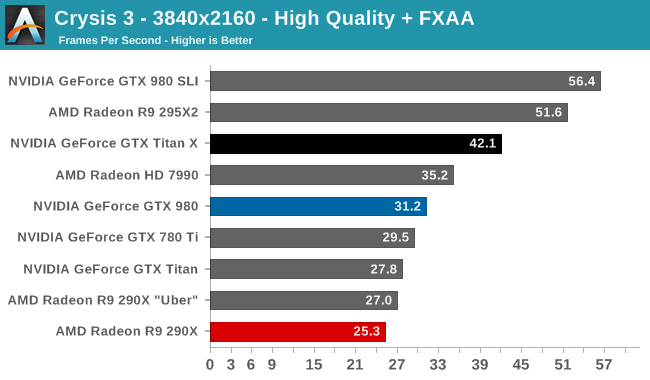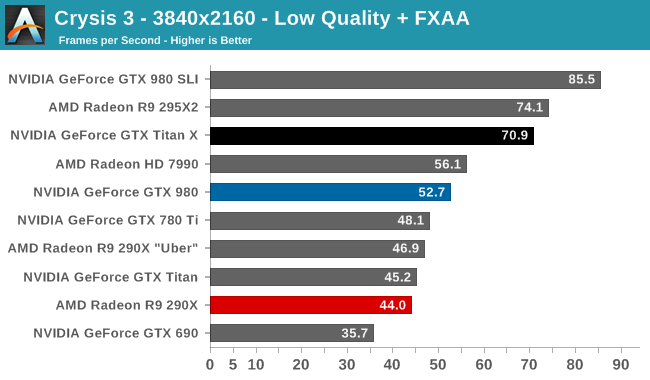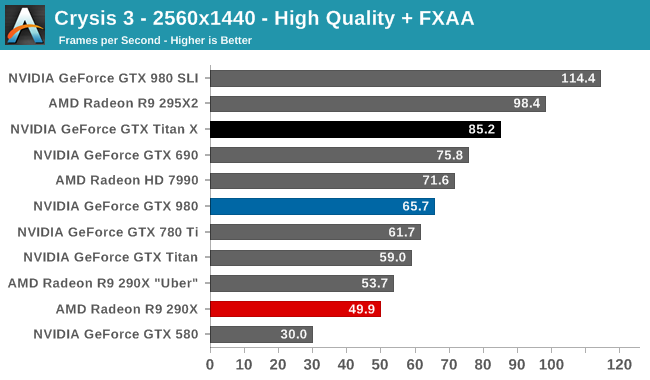The NVIDIA GeForce GTX Titan X Review
by Ryan Smith on March 17, 2015 3:00 PM ESTCrysis 3
Still one of our most punishing benchmarks, Crysis 3 needs no introduction. With Crysis 3, Crytek has gone back to trying to kill computers and still holds “most punishing shooter” title in our benchmark suite. Only in a handful of setups can we even run Crysis 3 at its highest (Very High) settings, and that’s still without AA. Crysis 1 was an excellent template for the kind of performance required to drive games for the next few years, and Crysis 3 looks to be much the same for 2015.



With GTX Titan X being based on the same iteration of the Maxwell architecture as the GTX 980 and its GM200 GPU essentially built as a GM204 + 50%, it comes as no surprise that the performance gains over GTX 980 are going to be rather consistent. In Crysis 3 the GTX Titan X holds a 35% performance lead at 4K, with that lead tapering slightly to 30% at 2560. Meanwhile the lead over the GK110 cards isn’t quite what we saw with BF4, dropping to around 45% and 55% for GTX 780 Ti and GTX Titan respectively.
As one of our most punishing games, this is also a good example of where even GTX Titan X will come up short at 4K. Even without MSAA and one step below Crysis 3’s Very High quality settings, the GTX Titan X can only muster 42fps. If you want to get to 60fps you will need to drop to Low quality, or drop the resolution to 1440p. The latter will get you 85.2fps at the same quality settings, which again highlights GTX Titan X’s second strength as a good card for driving high refresh rate 1440p displays.
Meanwhile this is another game where our multi-GPU cards still pull ahead, reminding us of the spoiler potential for the R9 295X2 and the GTX 980 SLI. In fact AMD gets some very good scaling here, and they need it as the GTX Titan X bests the R9 290XU by 56% at 4K High.










276 Comments
View All Comments
Kevin G - Tuesday, March 17, 2015 - link
Last I checked, rectal limits are a bit north of 700 mm^2. However, nVidia is already in the crazy realm in terms of economics when it comes to supply/demand/yields/cost. Getting fully functional chips with die sizes over 600 mm^2 isn't easy. Then again, it isn't easy putting down $999 USD for a graphics card.However, harvested parts should be quiet plentiful and the retail price of such a card should be appropriately lower.
Michael Bay - Wednesday, March 18, 2015 - link
>rectal limits are a bit north of 700 mm^2Oh wow.
Kevin G - Wednesday, March 18, 2015 - link
@Michael BayIntel's limit is supposed to be between 750 and 800 mm^2. They have released a 699 mm^2 product commercially (Tukwilla Itanium 2) a few years ago so it can be done.
Michael Bay - Wednesday, March 18, 2015 - link
>rectal limitsD. Lister - Wednesday, March 18, 2015 - link
lolchizow - Tuesday, March 17, 2015 - link
Yes its clear Nvidia had to make sacrifices somewhere to maintain advancements on 28nm and it looks like FP64/DP got the cut. I'm fine with it though, at least on GeForce products I don't want to pay a penny more for non-gaming products, if someone wants dedicated compute, go Tesla/Quadro.Yojimbo - Tuesday, March 17, 2015 - link
Kepler also has dedicated FP64 cores and from what I see in Anandtech articles, those cores are not used for FP32 calculations. How does NVIDIA save power with Maxwell by leaving FP64 cores off the die? The Maxwell GPUs seem to still be FP64 capable with respect to the number of FP64 cores placed on the die. It seems what they save by having less FP64 cores is die space and, as a result, the ability to have more FP32 cores. In other words, I haven't seen any information about Maxwell that leads me to believe they couldn't have added more FP64 cores when designing GM200 to make a GPU with superior double precision performance and inferior single precision performance compared with the configuration they actually chose for GM200. Maybe they just judged single precision performance to be more important to focus on than double precision, with a performance boost for double precision users having to wait until Pascal is released. Perhaps it was a choice between making a modest performance boost for both single and double precision calculations or making a significant performance boost for single precision calculations by forgoing double precision. Maybe they thought the efficiency gain of Maxwell could not carry sales on its own.testbug00 - Tuesday, March 17, 2015 - link
If this is a 250W card using about the same power as the 290x under gaming load, what does that make the 290x?Creig - Tuesday, March 17, 2015 - link
A very good value for the money.shing3232 - Tuesday, March 17, 2015 - link
Agree.